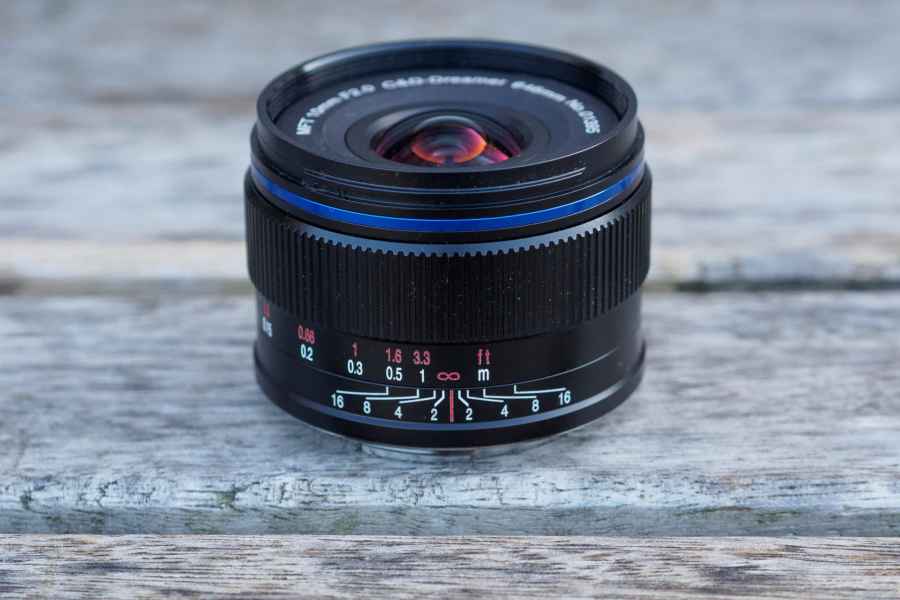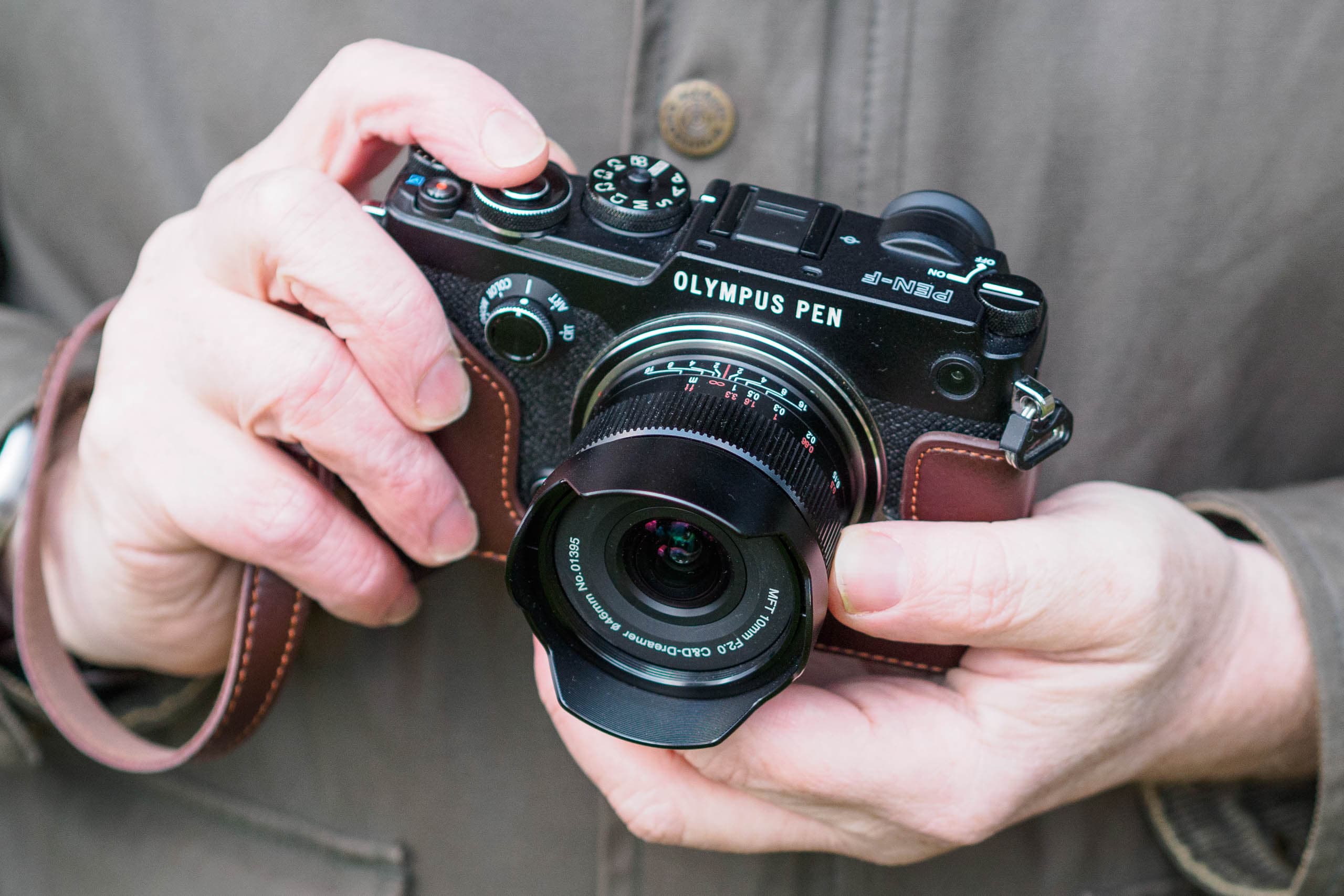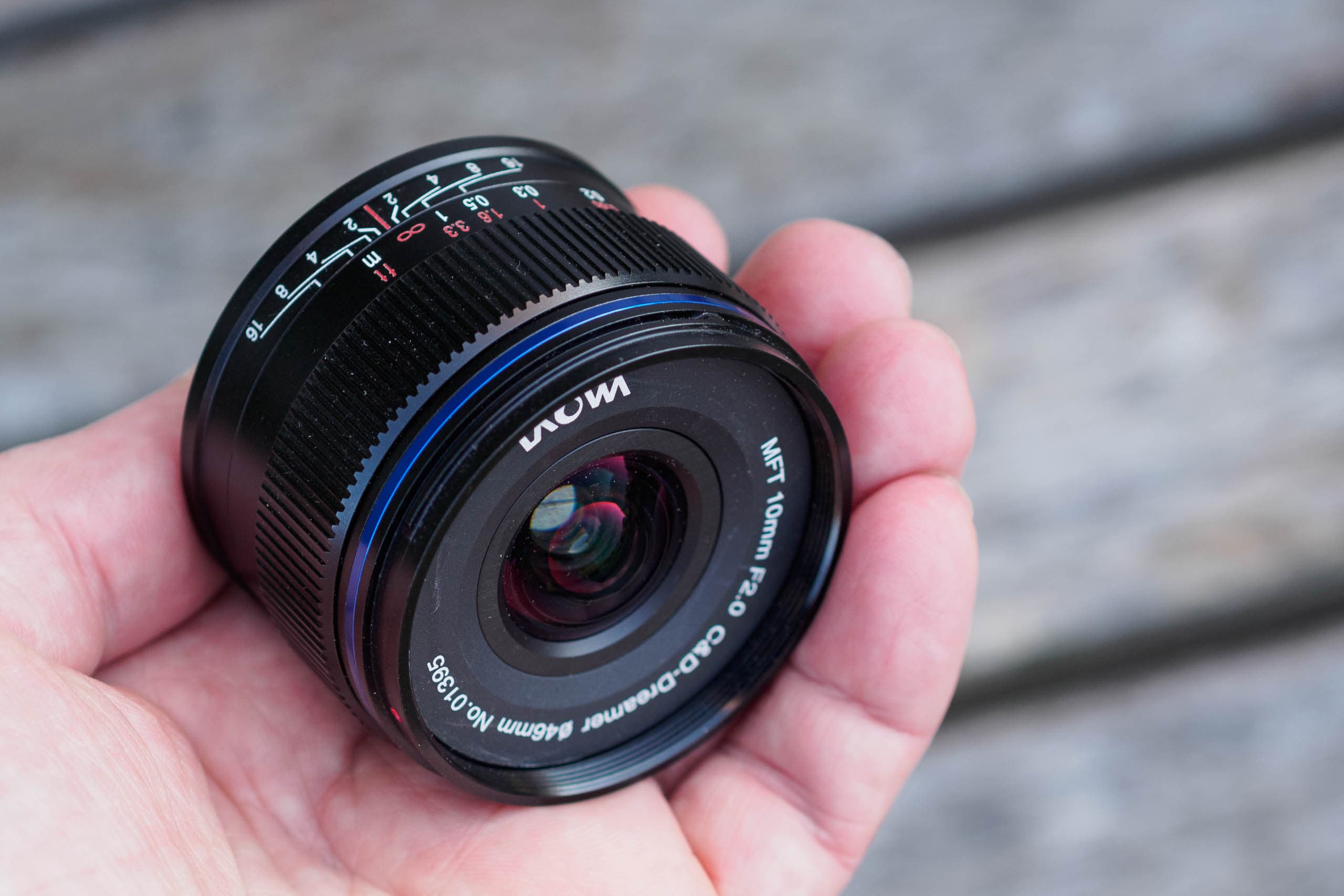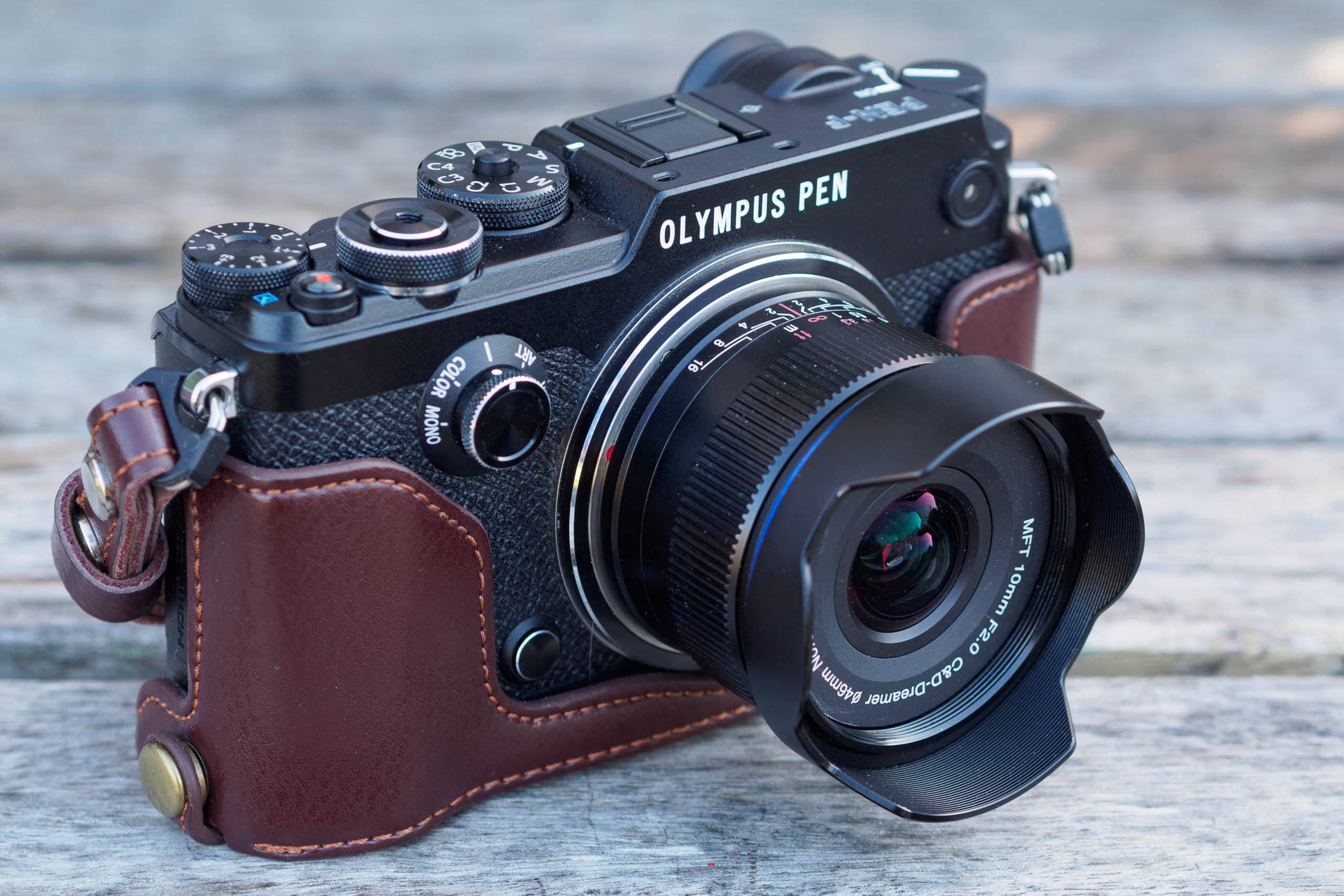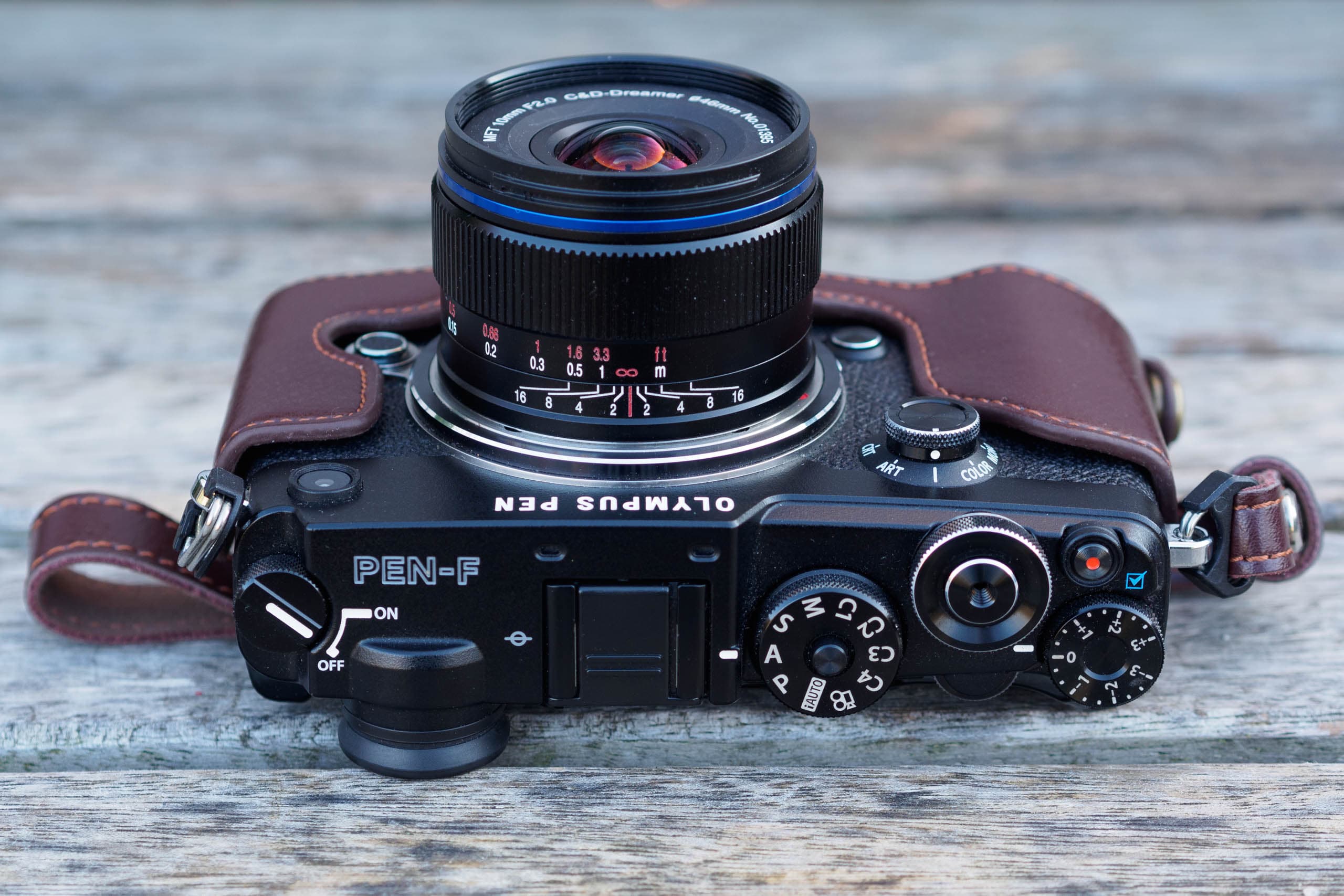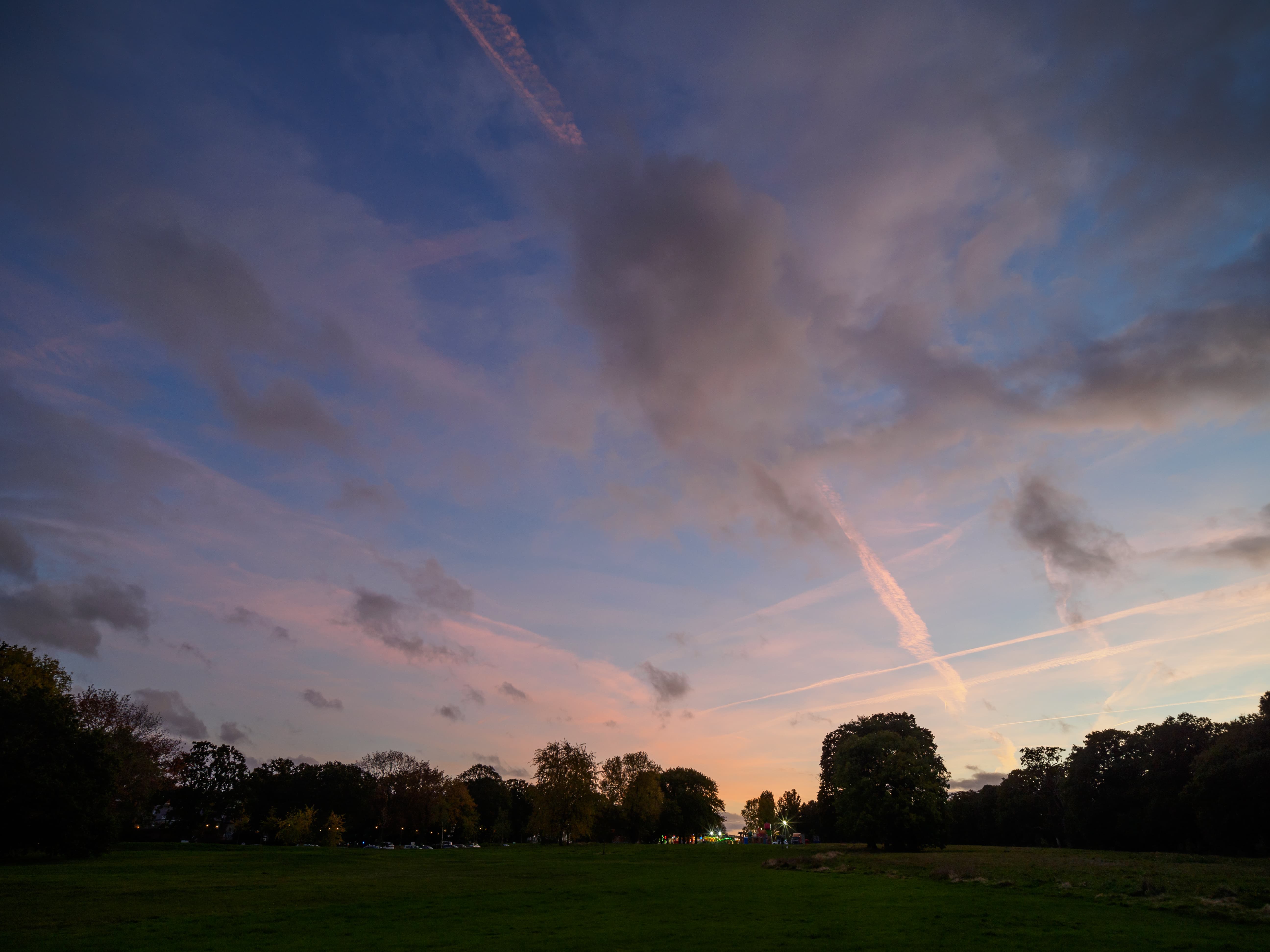Made by Venus Optics, the Laowa 10mm f/2 Zero-D MFT is a wideangle prime lens designed for the Micro Four Thirds format. This lens was announced in late 2020 and viewed from the front you can see that it’s labelled MFT 10mm f/2 C&D Dreamer, but if you go shopping for one search for (Venus Optics) Laowa 10mm f/2 Zero-D MFT. It’s priced at $349/£399 for a new sample. For more options have a look at the best Micro Four Thirds lenses.
Laowa 10mm f/2 Zero-D MFT – At a glance
- $349/£399
- Wideangle prime for Micro Four Thirds
- 20mm equivalent angle of view
- 41mm long, 53mm diameter, 125g
- Takes 46mm filters
Micro Four Thirds is the longest-running mirrorless system of all, having been launched by Panasonic and Olympus back in 2008 and it is well supported with lenses from its parent brands as well as optics from third party manufacturers including Samyang, Sigma and Voigtlander as well as Laowa.
The Laowa 10mm f/2 Zero-D MFT is tiny at just 41mm long, 53mm in diameter and weighs a mere 125g. It’s in a similar ballpark size-wise to MFT classics like the Panasonic Leica DG 15mm f/1.7 Asph at $548/£449 and the Olympus M.Zuiko Digital 17mm f/1.8 at $400/£399. It’s also smaller than Laowa’s other ultra-wide offerings for the MFT format, the 9mm f/2.8 Zero-D and 7.5mm f/2.
With its 20mm equivalent angle of view, the Laowa 10mm f/2 Zero-D MFT looks like it could be an ideal travel companion to a standard zoom, offering a usefully wider perspective coupled with a low-light friendly f/2 aperture. Its claimed low distortion, 12cm minimum focusing and five blade diaphragm which produces ten-point sunstars gives the lens creative options too Thanks to its $349/£399 price tag, it’s also the most affordable MFT ultra-wide; even the ‘budget’ Olympus M.Zuiko Digital ED 9-18mm f/4-5.6 zoom costs $586/£599. In principle there’s a lot to like here, but how does it measure up in practice?
Laowa 10mm f/2 Zero-D MFT: Features
Like all Laowa lenses, the 10mm f/2 is manual focus only. However, unlike the others I’ve reviewed, it doesn’t have a manual aperture ring. This is because Venus Optics joined the Micro Four Thirds System Standard group in early 2020, allowing it to make lenses with electronic aperture control operated from the camera body. This brings additional advantages: the lens also tells the camera its focal length so the in-body image stabilisation will work correctly, and can automatically engage focus aids when the manual focus ring is turned.
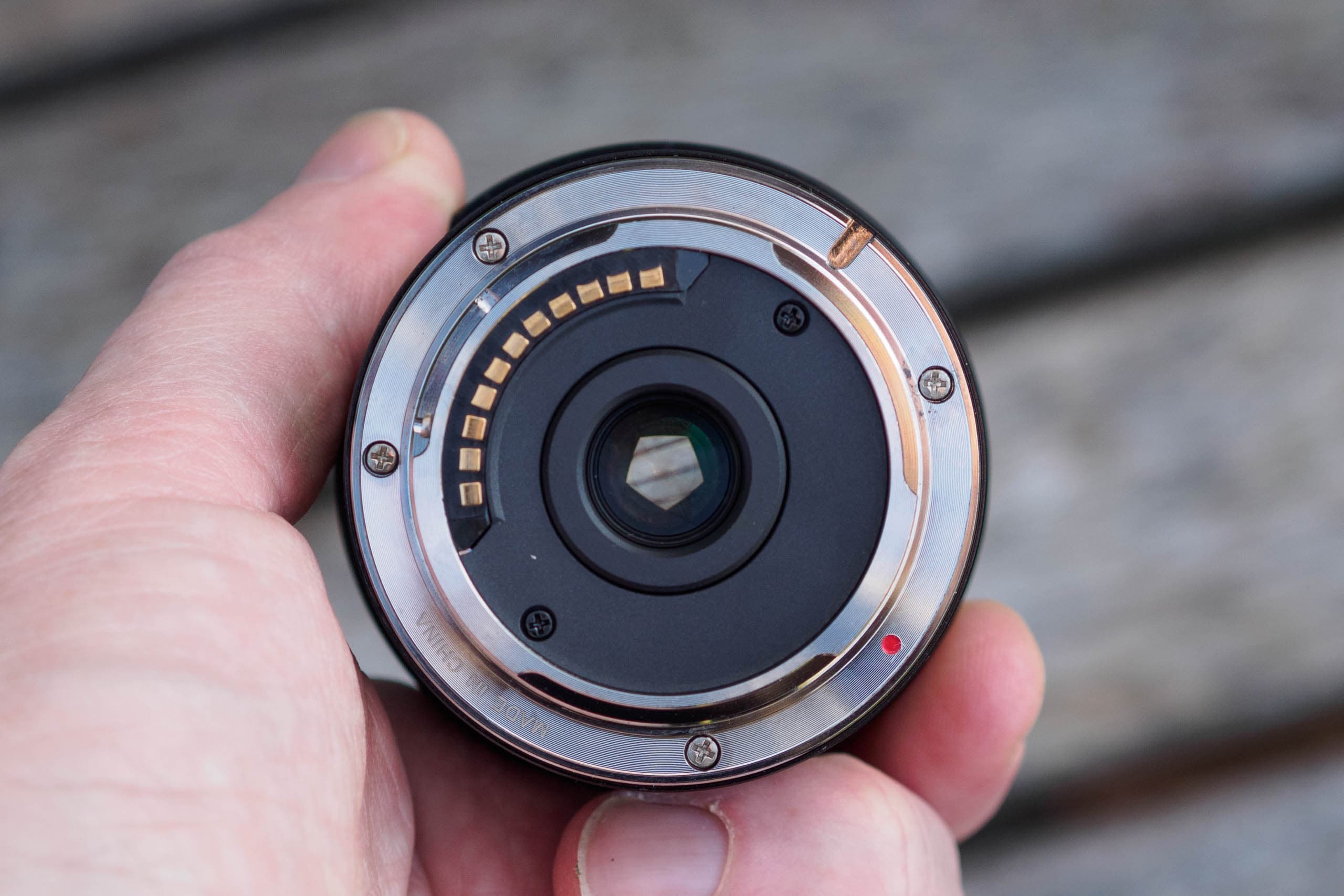
Electronic contacts on the mount allow the lens to communicate with the camera. Here you can also clearly see the five-bladed aperture
Optically, the lens employs 11 elements in 7 groups, including three made from ED glass and two with aspherical profiles to suppress chromatic aberration and distortion. Indeed, Venus Optics classifies it as a ‘Zero-D’ lens, meaning that rectilinear distortion should be practically non-existent. The aperture diaphragm is kept simple, employing five straight blades, with the aim of producing ten-ray sun stars for landscape shooters.
Focusing works by moving the rear elements, with a minimum distance of just 12cm. This means that the 46mm filter thread doesn’t rotate, which is always good news for filter users. A metal petal-type hood is supplied in the box and attaches via is own bayonet fitting, reversing neatly for storage.
Laowa 10mm f/2 Zero-D MFT: Build and Handling
Despite its light weight of just 125g, the Laowa MFT 10mm f/2 is really nicely made. Its all-metal barrel is dominated by the wide, finely ridged manual focus ring that falls perfectly to hand when shooting. This rotates beautifully smoothly, with just the right amount of resistance to be easy to turn, but difficult to nudge accidentally. Laowa’s signature metallic blue ring at the front adds a touch of panache to the styling. However, it’s worth noting that the lens makes no claim to being weather-sealed.

Here’s how the lens looks on various different sized cameras: Olympus E-M5 II and E-M1 III (back), Olympus PEN-F and Panasonic Lumix GM1 (front)
This is the kind of compact, lightweight optic that barely makes its presence felt on the camera. It’s a good fit to small Olympus OM-D E-M10 and E-M5 series bodies that have little in the way of a handgrip, but perhaps most perfectly matched to small rangefinder-style models such as the Panasonic Lumix GX9 and the classic Olympus PEN-F. I mostly used it on the latter for this review. One quirk is that on certain ultra-compact Lumix models such as the GM1, it will only work with the electronic, rather than mechanical shutter.
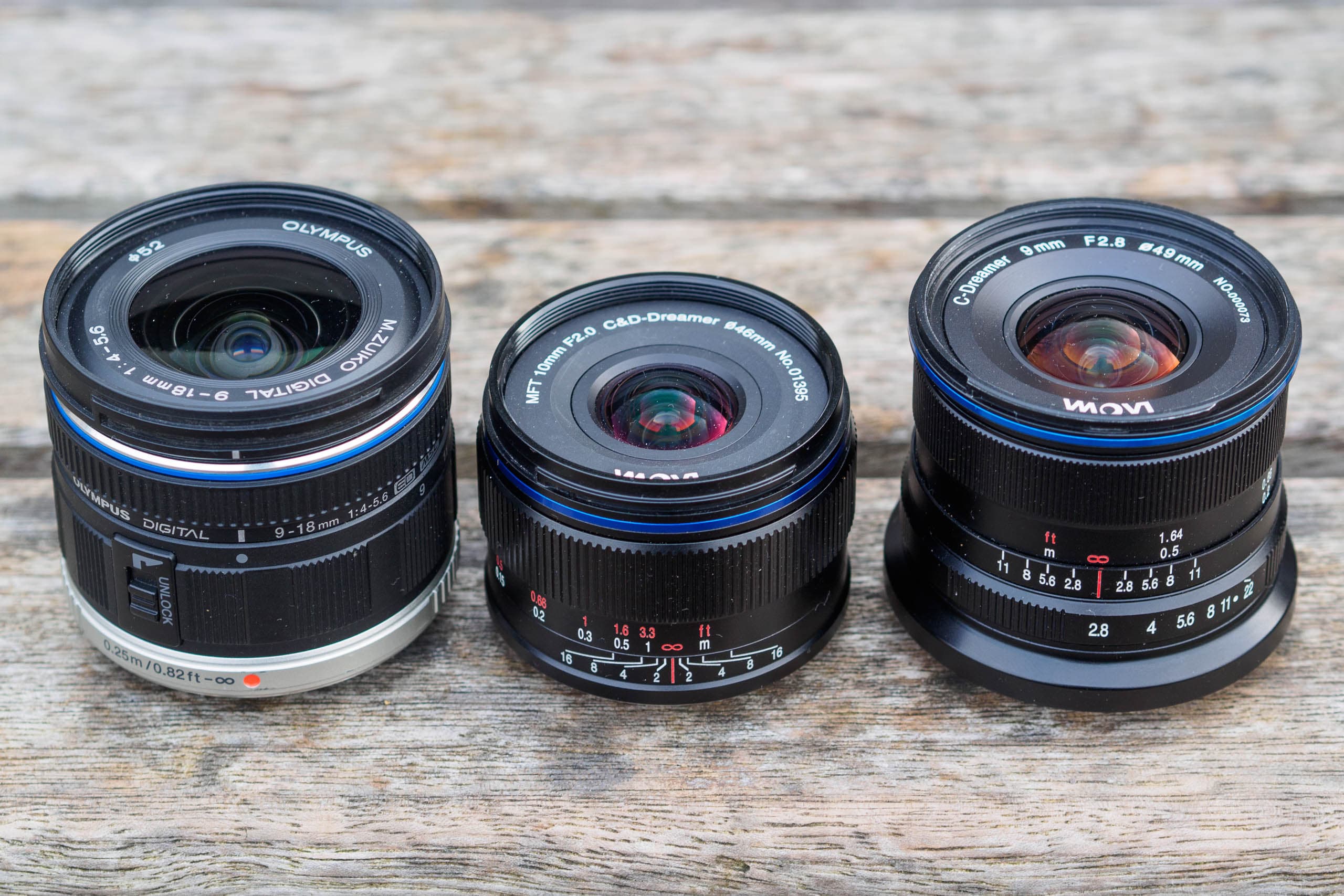
The Laowa MFT 10mm f/2 is smaller and lighter than either the Olympus 9-18mm zoom (left), or its 9mm f/2.8 sibling (right)
It’s difficult to overstate how positive an impact the electronic design has on the experience of using the lens. Unlike Laowa’s older, unchipped designs, you don’t have to worry about manually setting the focal length for the camera’s IBIS system, and aperture control works just like your other lenses. The only difference is the lack of autofocus.
Laowa 10mm f/2 Zero-D MFT: Focusing
You could be forgiven for being sceptical about buying a manual-focus lens; why give up the convenience of autofocus? But in practice, thanks to the Laowa MFT 10mm f/2’s ability to activate magnified view or peaking automatically, manual focusing is a breeze. You simply place the focus point where you want it and then turn the focus ring. When the zoomed-in view is sharp, you’re good to go.

The Laowa MFT 10mm f/2 is easy to focus, as turning the manual focus ring automatically engages your preferred focus aid. Olympus PEN-F, 1/13sec at f/2, ISO 200
As this is a wideangle lens being used on a relatively small sensor, it provides extensive depth-of-field. This means that you can also use hyperfocal and zone focusing techniques very easily.
Distance and depth-of-field scales are marked on the barrel, and if you set the focus to 1m and the aperture to f/8, everything from 0.5m to infinity should be acceptably sharp. At least according to the conventional definition for making prints; your files may not hold up so well if you demand critical pixel-level sharpness.
Laowa 10mm f/2 Zero-D MFT: Performance
Given that we’re looking at a 20mm equivalent f/2 lens that’s just 53mm in diameter, we shouldn’t be too surprised to find that some optical compromises have been made in the design. Most obviously, at large apertures it isn’t super-sharp towards the edges, while suffering from marked vignetting.

Here I composed the image using in-camera Keystone Correction to visualise the composition, then tidied up and toned the image in Adobe Camera Raw. Olympus PEN-F, 1sec at f/11, ISO 200, hand-held
However, assessing this lens based on close-range test chart or brick wall shots alone risks misjudging its abilities significantly. If you play to its strengths rather than dwell on its weaknesses, it will reward you with stunningly sharp, detailed images.
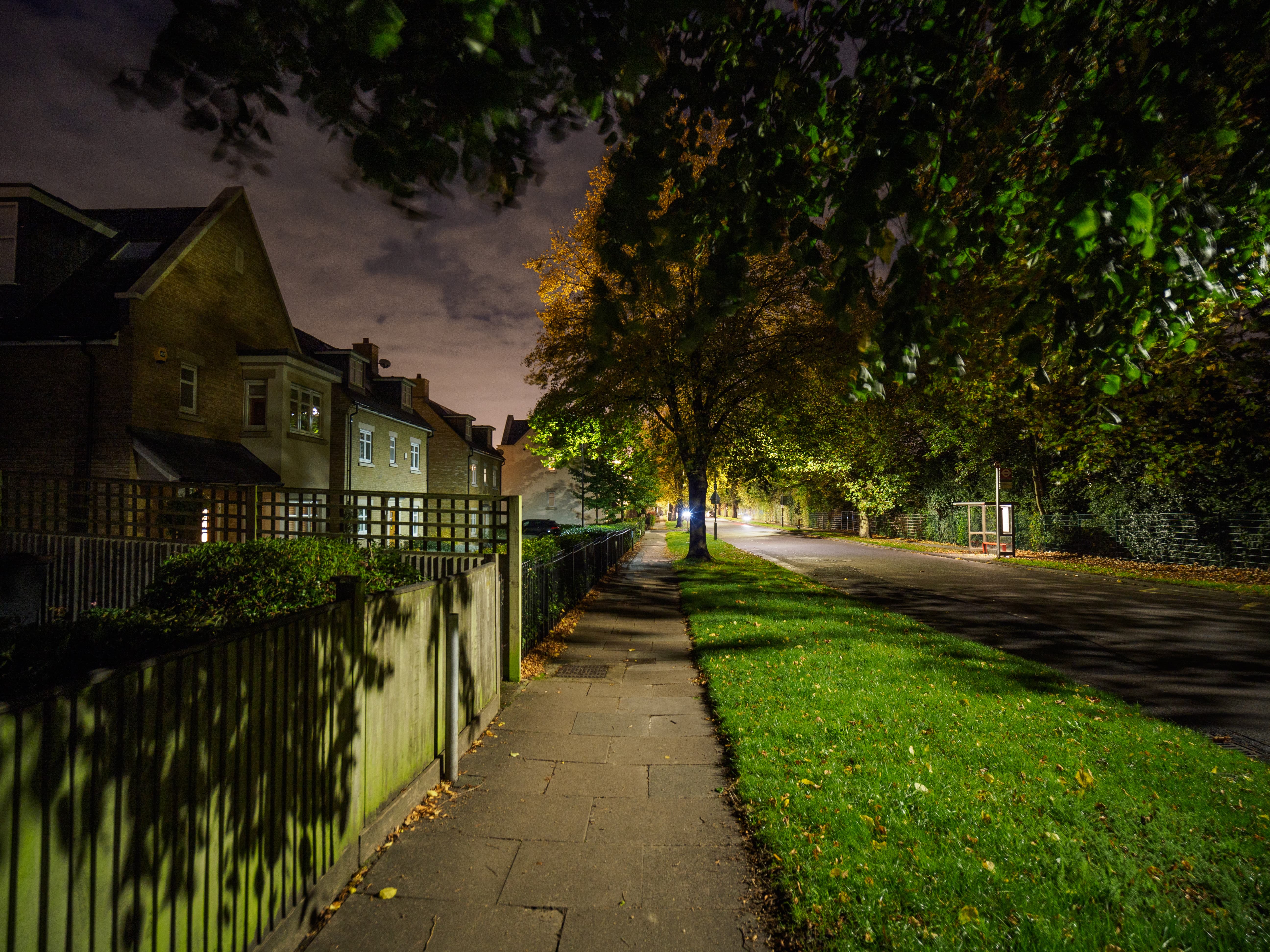
The corners may not be super-sharp at f/2, but a lot of the time, that doesn’t really matter. Olympus PEN-F, 0.5sec at f/2, ISO 200
Let’s take a closer look. At f/2, the lens is already impressively sharp in the centre of the frame, and continues to render fine detail nicely out to the top and bottom edges. It then gets increasingly blurry towards the corners, with point light sources becoming elongated due to astigmatism.

Stop down the aperture and the lens gives sharp detail across the entire frame. Olympus OM-D E-M1 Mark III, 1/160sec at f/6.3, ISO 200
As expected, stopping down causes everything to sharpen up dramatically, and by f/5.6 the lens delivers superb levels of details from corner to corner. I’d avoid using apertures smaller than f/11, though, because this always leads to excessive diffraction softening on Micro Four Thirds.
Crucially, three-dimensional real-world scenes tend to look better than test shots of flat subjects, especially at intermediate apertures around f/2.8-f/4. Examining the images closely reveals curvature of field, with the edges and corners coming into sharp focus at a closer distance than the centre. As a result, if you want the best cross-frame sharpness for long-distance shots, it can be better to nudge the focus ring slightly past its infinity mark.
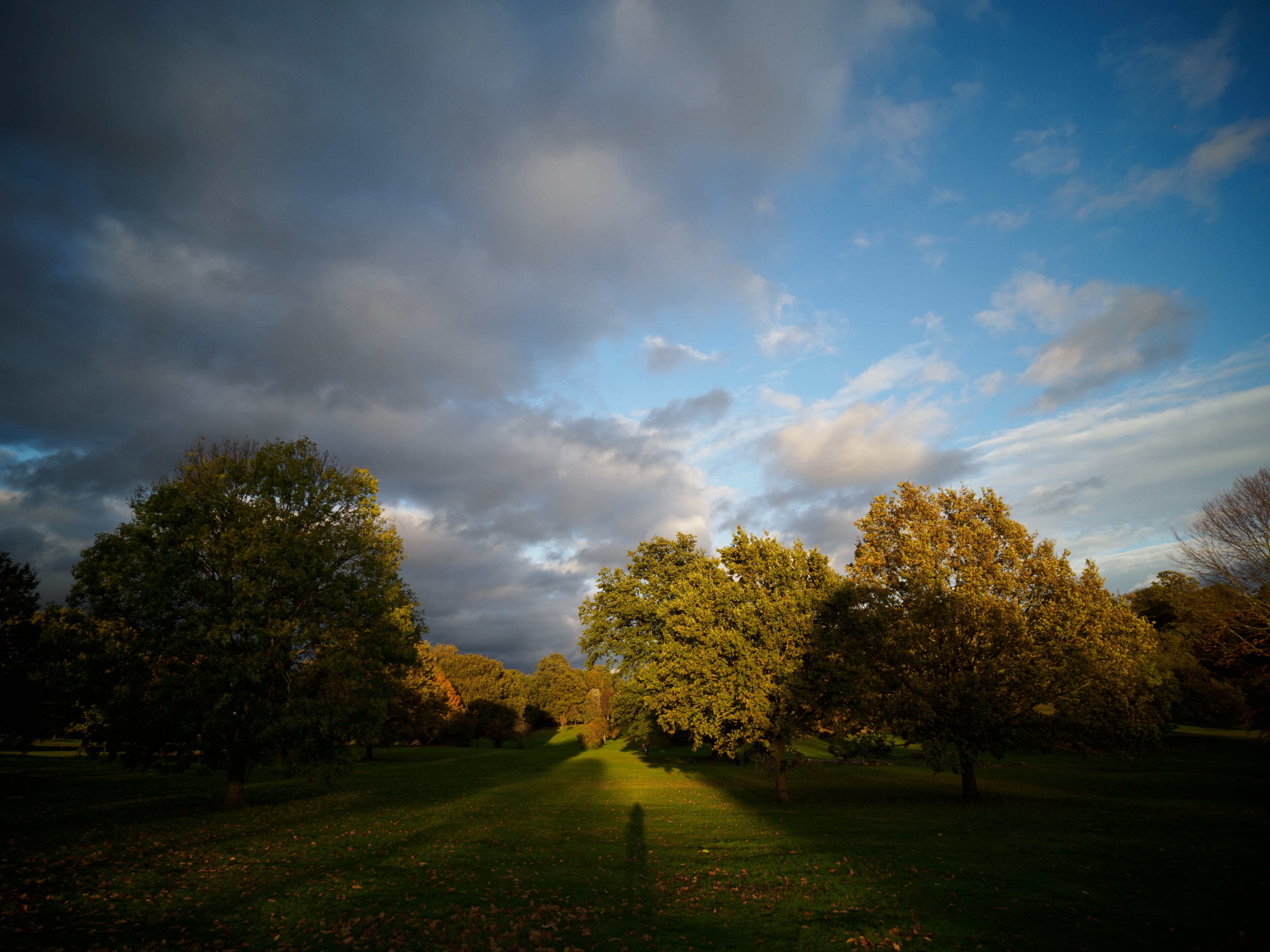
Strong vignetting can be visible at f/2. It’s most obvious here in the top corners of the frame. Olympus PEN-F, 1/2000sec at f/2, ISO 200
There’s pronounced vignetting at f/2, with the corners of the frame darkening abruptly. While this isn’t always a bad thing, it can look ugly on an otherwise evenly toned image. However it’s straightforward to address in raw processing. The vignetting reduces significantly at f/2.8 and has pretty much gone by f/4.
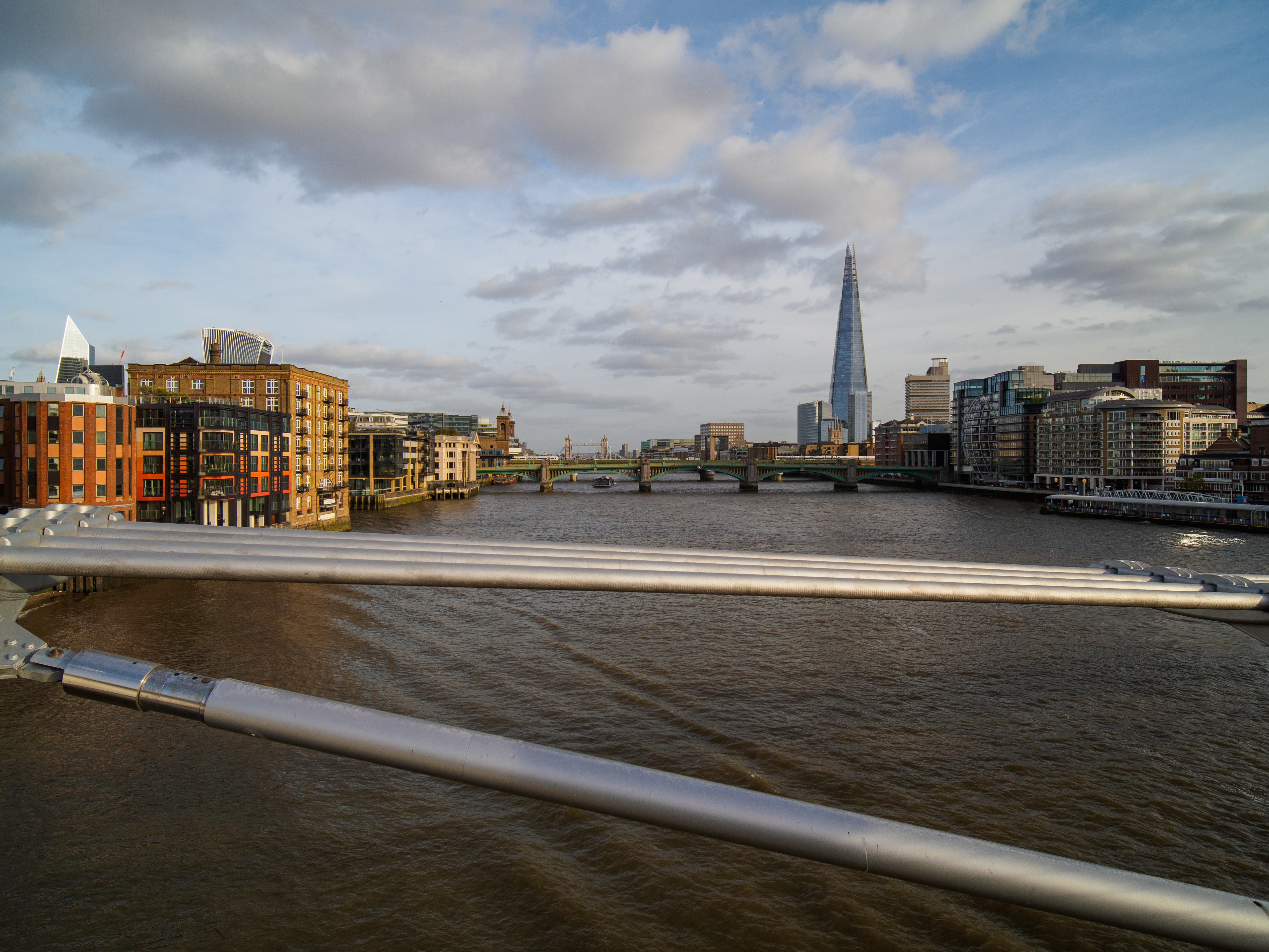
A little chromatic aberration is visible at the edges of the frame. Olympus PEN-F, 1/1000sec at f/4, ISO 200
A little green and magenta colour fringing can be visible in both JPEG and raw files along high-contrast edges towards the corners of the frame, due to lateral chromatic aberration. Normally this is suppressed by Micro Four Thirds cameras using profiled correction data passed from the lens, but it’s clear Laowa isn’t doing that here.
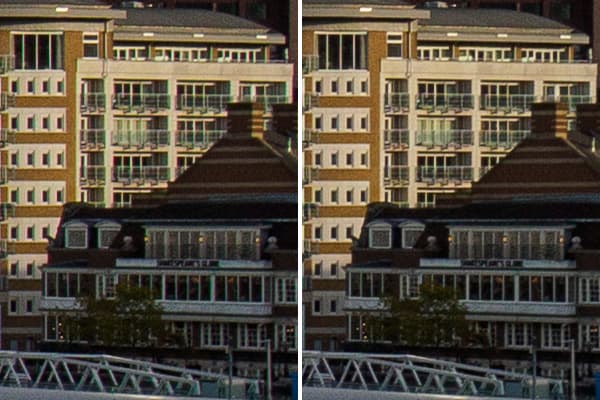
The 100% crop on the left shows a little colour fringing, but it’s a simple fix in raw processing (right)
However, the fringing is very slight, and a one-click fix in Adobe software on the rare occasions that it’s troublesome.

Thanks to its minimal distortion, the lens is great for achitecture. Olympus PEN-F, 1/320sec at f/5.6, ISO 200
One area where the lens excels is with regards to distortion. As promised by the Zero-D designation, there simply isn’t any visible at all, with straight lines along the edges of the frame being rendered correctly. This is a real boon when shooting architecture, and means that the 10mm f/2 works well with both in-camera Keystone Compensation and geometry corrections in raw processing.

Flare can occasionally be a problem with oblique direct sunlight. Olympus PEN-F, 1/640sec at f/5.6, ISO 200
I had no problems shooting directly into bright light, with contrast maintained impressively well. Instead, flare tends to be most problematic when the sun strikes the front element at an oblique angle. So as usual it’s best practice to use the hood, not just to block stray light, but also to help protect the front element.

Thanks to its aperture diaphragm’s five straight blades, the lens gives well-defined sun-stars. Olympus PEN-F, 1/500sec at f/5.6, ISO 200
On a more positive, the lens renders attractive, well-defined 10-ray sunstars at surprisingly large apertures, with f/5.6 perhaps being the optimum setting. But you can even get subtle star effects from streetlights at apertures as large as f/2.8.
Laowa 10mm f/2 Zero-D MFT: Verdict
With its tiny size and sharp optics, the Laowa MFT 10mm f/2 is a classic example of what Micro Four Thirds does best. It offers very acceptable image quality when used wide open, and excellent results when stopped down. Yet it’s so small and light that you can throw it in a bag or pocket and carry it around all day without noticing. It may not autofocus, but it makes manual focus so easy that it just doesn’t matter. And thanks to its electronics, in other respects it works much the same as conventional AF lenses.
It also fits nicely into a camera system as a whole. It’s a fine complement to a standard zoom, offering a usefully wider field of view and a large maximum aperture. This makes it a great choice for shooting architecture and landscapes, or in low light.
Compared to the obvious alternatives, the 10mm makes a strong case for itself. It’s considerably sharper than the Olympus 9-18mm f/4-5.6, while being smaller, lighter and cheaper. I’d also choose it ahead of its 9mm f/2.8 stablemate, thanks to its smaller size, larger aperture and electronic operation. For Micro Four Thirds users who’d like a pocket-friendly wideangle, it’s a great choice.

Laowa 10mm f/2 Zero-D MFT: Full Specifications
Follow AP on Facebook, Twitter, Instagram, YouTube and TikTok.

